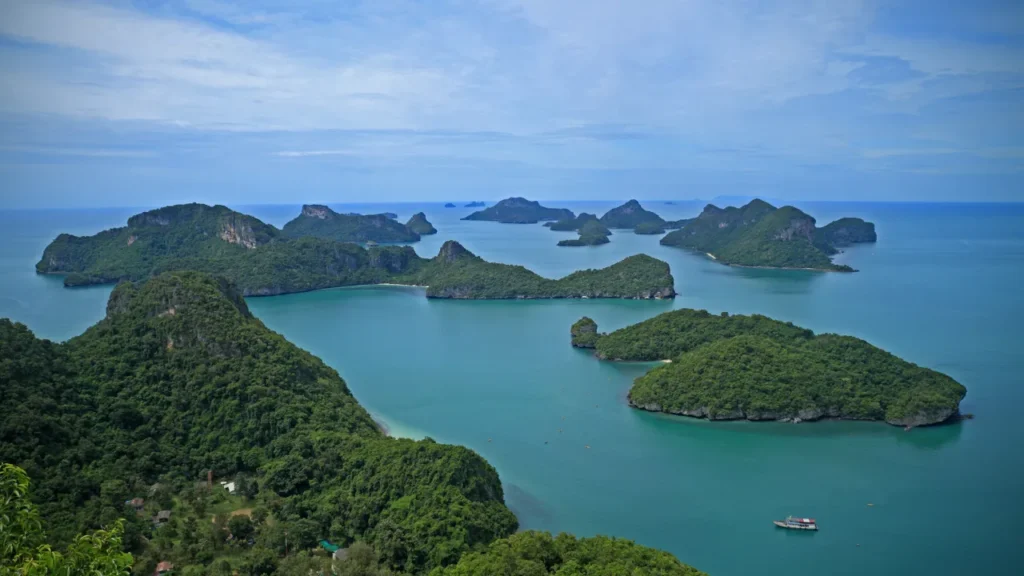Each year, from November to April, divers from around the world head to Thailand’s Similan and Surin Islands in search of crystal-clear water, thriving coral reefs, and world-famous dive sites like Richelieu Rock. If that sounds like your kind of adventure, you’re in the right place. In this post, I’m sharing what it’s like to explore the Similan Islands by liveaboard—complete with daily dive life, incredible marine life, and everything you need to know before booking your own trip.
I was first introduced to the Similan Islands last year when my husband was doing his Divemaster in Koh Tao. We kept meeting people who would tell us stories of their trips there, which were always full of unique marine life, clear waters, and beautiful dive sites.
Before you knew it, Richelieu Rock and a Similan Islands liveaboard were inching their way up my diving bucket list.
Fast-forward to this season. Our friends went over to work on a liveaboard called the Blue Dolphin. I reached out to Will on Instagram and asked if there was space for us to join them for a trip in April. Who knew that quick message would lead to one of the best trips of my life?
So, if you’ve been considering booking a Similan Islands liveaboard to do some of the best diving in Thailand, this guide is for you.
Please note: This post may contain affiliate links, meaning I may earn a commission if you make a purchase by clicking a link (at no extra cost to you). Thank you for supporting my blog!



Table of Contents
- What’s a Liveaboard?
- Why Dive the Similan & Surin Islands?
- Best Time to Dive the Similan & Surin Islands
- Trip Overview: My Similan Island Liveaboard Experience
- Daily Life Onboard a Liveaboard
- My Favorite Dive Sites
- Safety Considerations and Dive Conditions
- Booking and Costs
- Tips for First-Time Liveaboard Divers
- FAQs
What is a Liveaboard?
Let’s start with the basics: What is a liveaboard? Think of it as your floating home for the trip. These boats are set up specifically for diving, serving as your accommodation, transportation, and even your meals, all while taking you to more remote, untouched dive sites far from shore.
A liveaboard allows you to explore dive sites too far from shore for regular day trips. You also get the chance to do multiple dives at the same dive site and be the first ones in the water at more popular sites. There are liveaboards worldwide, from Indonesia to Thailand to the Galapagos.
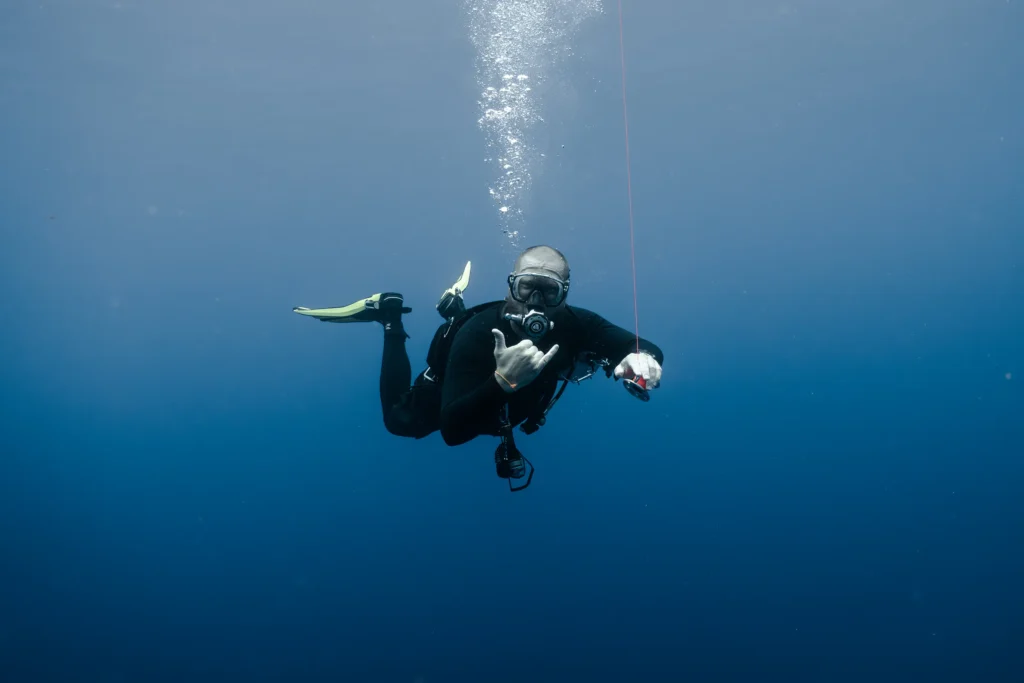
Why Dive the Similan & Surin Islands?
When people talk about booking a Similan Islands liveaboard, they’re talking about the Similan and Surin Islands. I didn’t know this until our trip; I always thought of it as the Similan Islands National Park, but it’s actually two groups of islands, each with unique underwater topography.
The world-famous Richelieu Rock? That’s actually in the Surin Islands!
So, what’s so special about the Similan and Surin islands? Why should they be added to your diving bucket list?
These dive sites are worth visiting because of their healthy coral reefs, crystal clear waters, and abundant fish life.
If you want to see schools and schools of fish, you need to go diving in Thailand: fusiliers, Barracuda, jackfish, batfish, glassfish, and so much more. My favorite things to see when diving are healthy coral reefs and thriving fish populations – and you get both of those on a Similan Islands liveaboard.
Of course, you also have the chance to see turtles, sharks, manta rays and the ever illusive whale shark if you’re lucky. I never go on a diving trip expecting to see whale sharks and manta rays – of course, they would be incredible to see – but the ocean is not a zoo, so it’s better to have no expectations. But they are out there. 😉
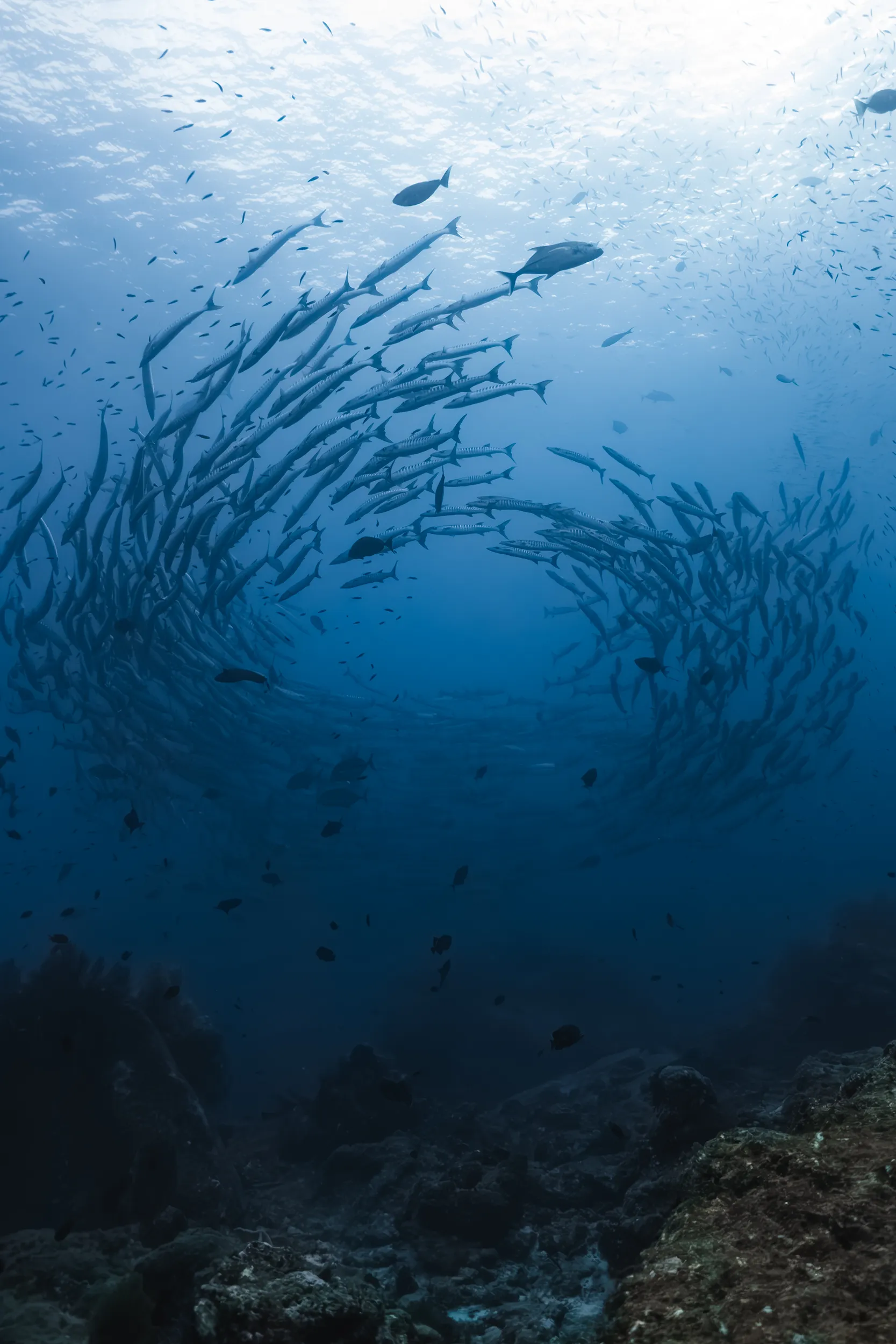
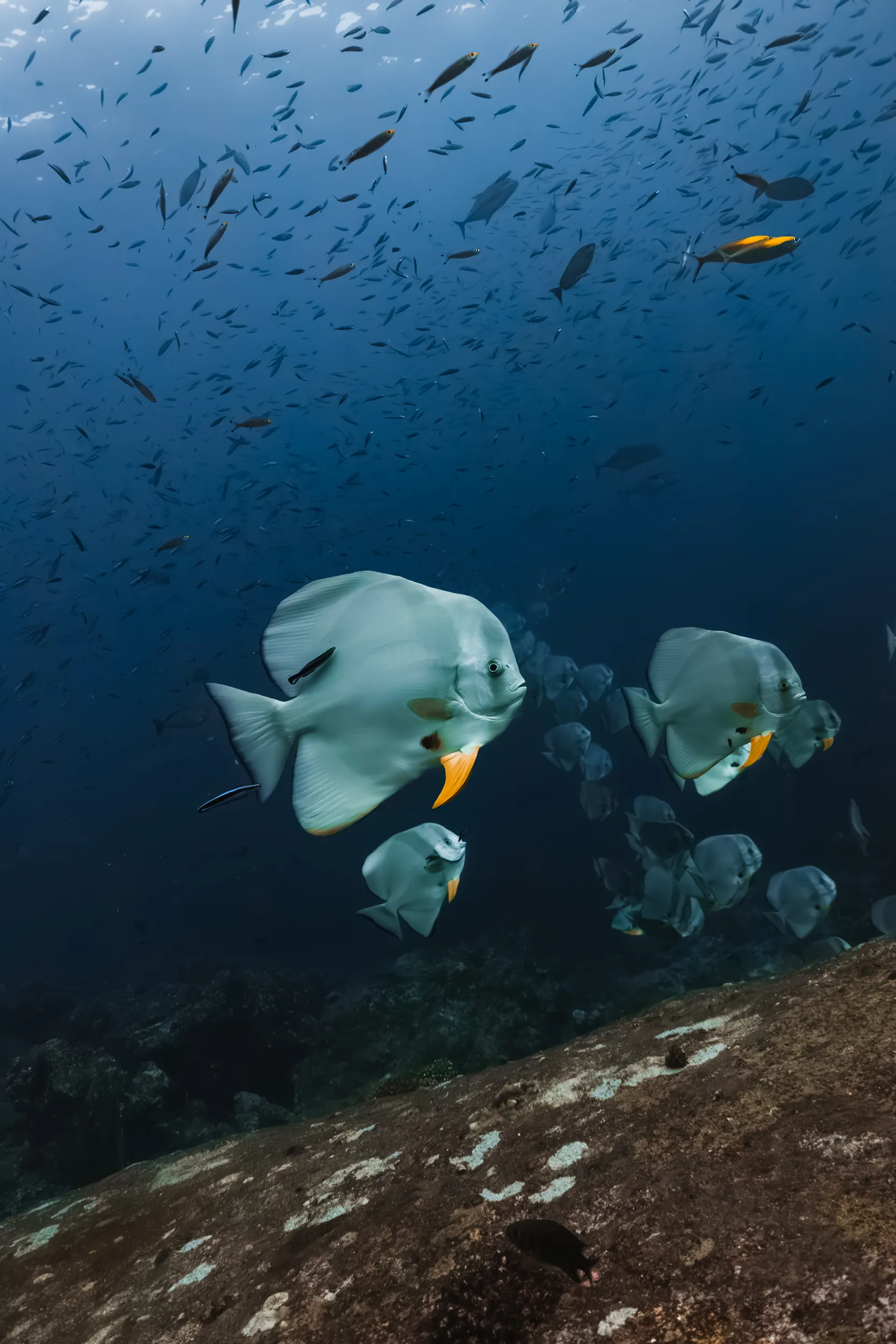
Best Time to Dive the Similan & Surin Islands
The Similan and Surin Islands are only open to divers for six months each year—from November through April. So, if you want to dive into this area, that’s your window.
When we started chatting with everyone onboard about planning a trip for next season, the advice was unanimous: avoid the major holidays like Christmas, New Year’s, and Songkran (Thai New Year in April). Aside from that, you really can’t go wrong.
I had some concerns about diving so close to the end of the season, but we honestly got lucky—with perfect weather, clear visibility, and mild currents the whole time.
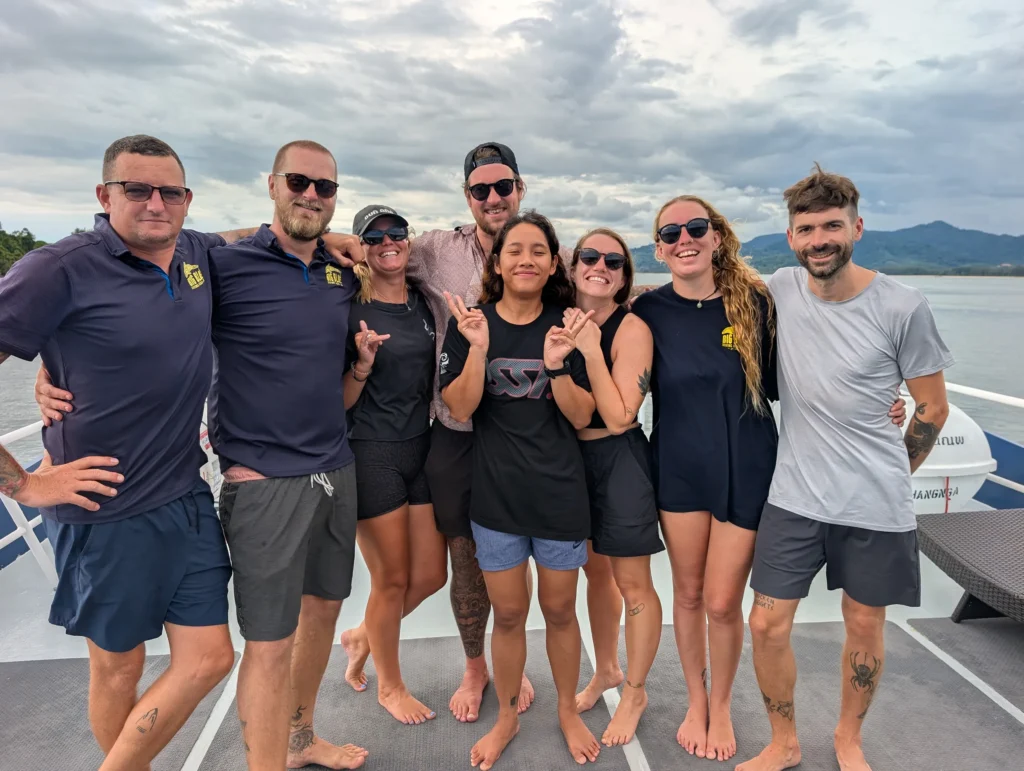
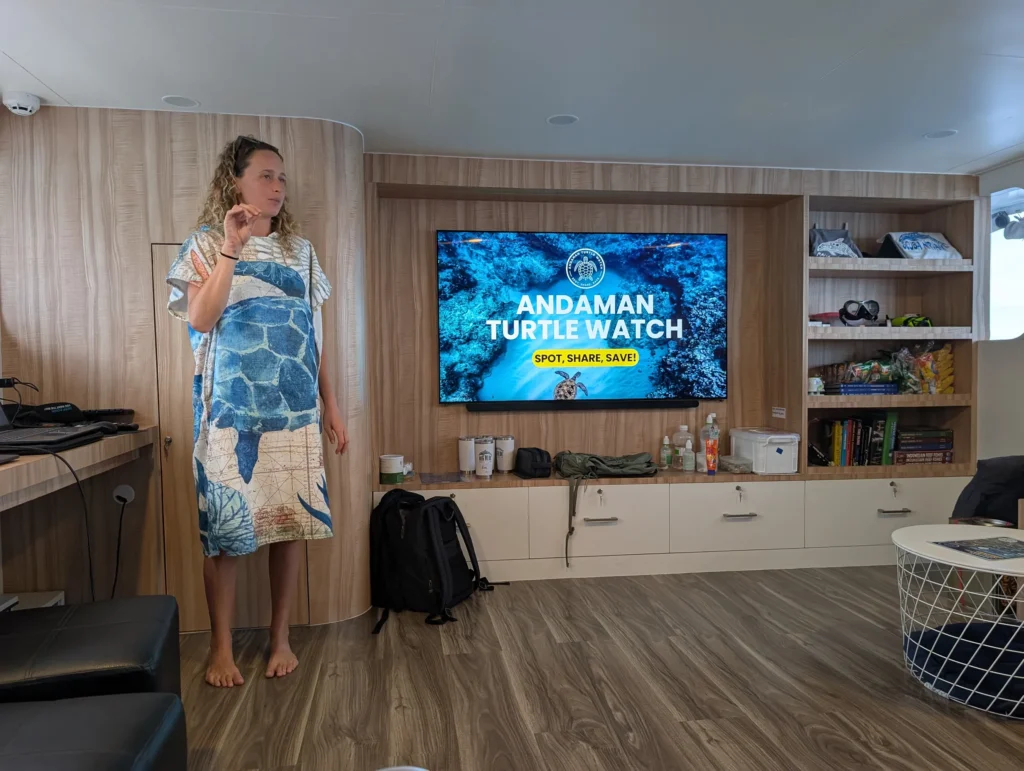
Trip Overview: My Similan Islands Liveaboard Experience
For this trip, we were on the Blue Dolphin with Big Blue Khoa Lak. It was our first liveaboard, so we weren’t sure what to expect, but the team went out of their way to make this trip special for us. We had Eve from Andaman Turtle Watch onboard for some talks about turtle conservation, and we got to dive with Will as our guide (our friend from Koh Tao!).
I’ve done a full review of our liveaboard experience, but for now, here are some details of our Similan Islands liveaboard experience!
Our trip lasted five days (four nights) and included 14 dives. We had Nitrox for the entire journey, which is highly recommended when doing multiple days of four dives daily.
We started our trip in the Similan Islands with a check dive. A check dive gives the dive guide an opportunity to see what you’re like as a diver – and they can make sure everyone in your group is of a similar skill level. Once the check dive is complete, you’ll dive with that same group for your trip.
Each dive starts and ends with the Blue Dolphin team picking you up in the dingy. No surface swims, ever – and I have to say I was very grateful for that.
After the check dive, it felt like the rhythm of the trip had begun. Eat, sleep, dive, repeat.
We did four dives a day for the first three days and two dives on our last day. There were daily naps, talks about turtles, and better food than I ever expected to get at sea. We watched the sunrise and had a beer with the sunset each evening.
I’ll be sharing more about our experience onboard the boat in my next post (which I’ll link here when it’s ready).
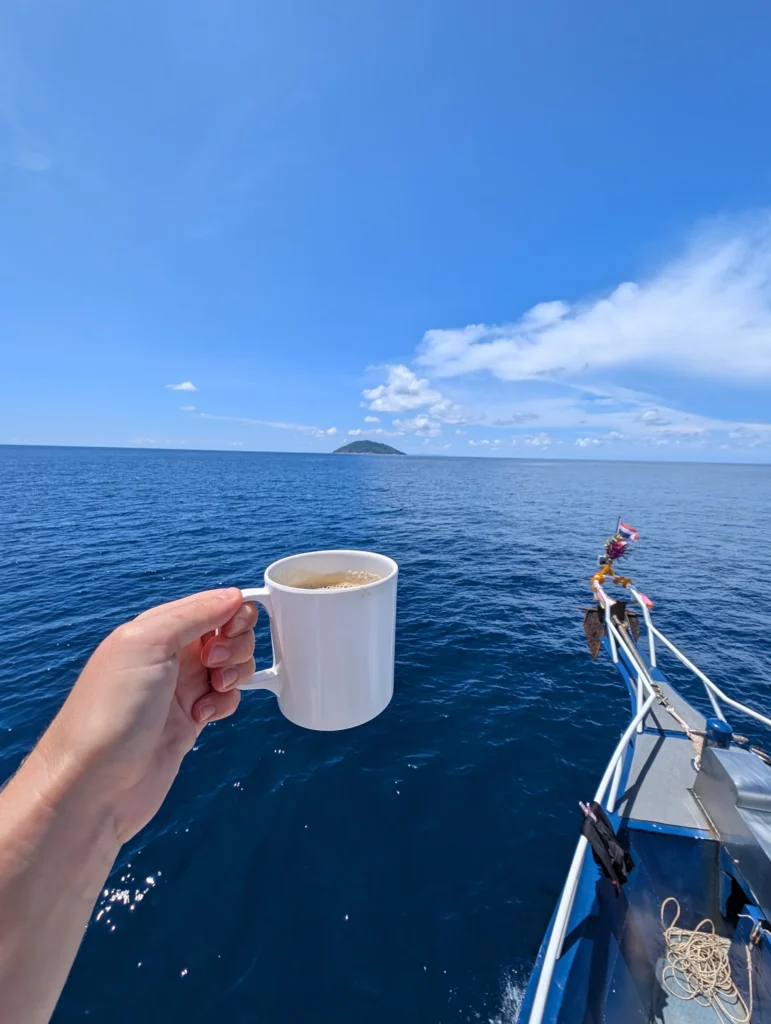
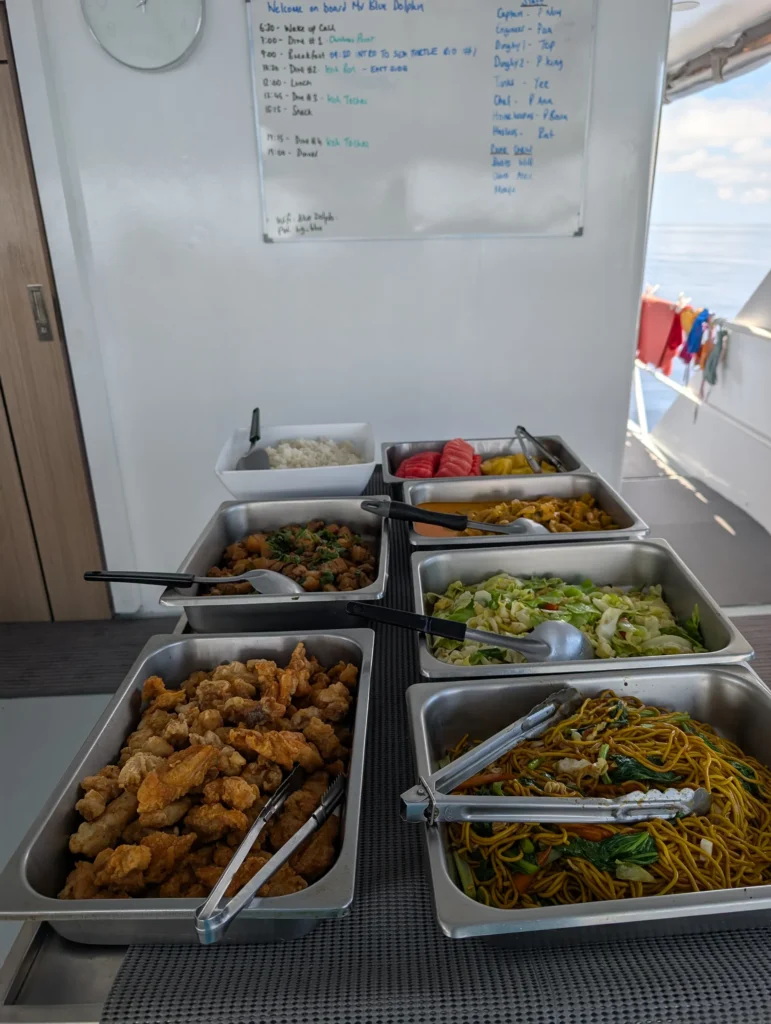
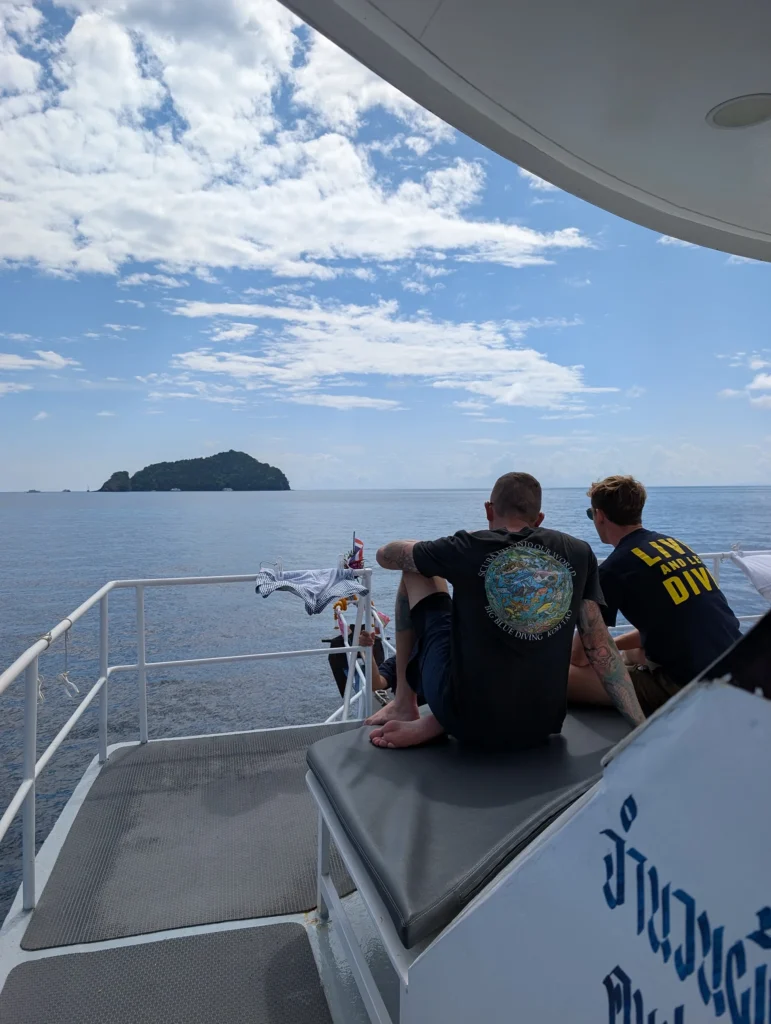
Daily Life Onboard a Liveaboard
On this trip, we had two mantras: eat, sleep, dive, repeat, and no wifi, just fish. Both sum up life on a Similan Islands liveaboard.
Each day started with a 6:30 AM wake-up call (though I’d recommend getting up around 6:00 to catch the sunrise). After coffee and a dive briefing, we’d jump in for our first dive around 7:00. Breakfast came next, followed by a turtle chat, another coffee, or just soaking up the view before gearing up for dive two.
After dive two came lunch—usually followed by a well-earned nap or an hour of reading in the sun. Then it was time for dive three, followed by snacks (seriously, the food was so good and so constant!). The final dive of the day was a sunset dive, which wrapped up just in time for a rooftop beer and dinner under the stars.
There were only a few variations to the daily routine: on day one, we had the chance to visit an island, and instead of a sunset dive, you could opt for a night dive.
Most evenings, we’d all hang out for a few hours after dinner—chatting, playing games, and winding down before another early night to do it all again the next day.
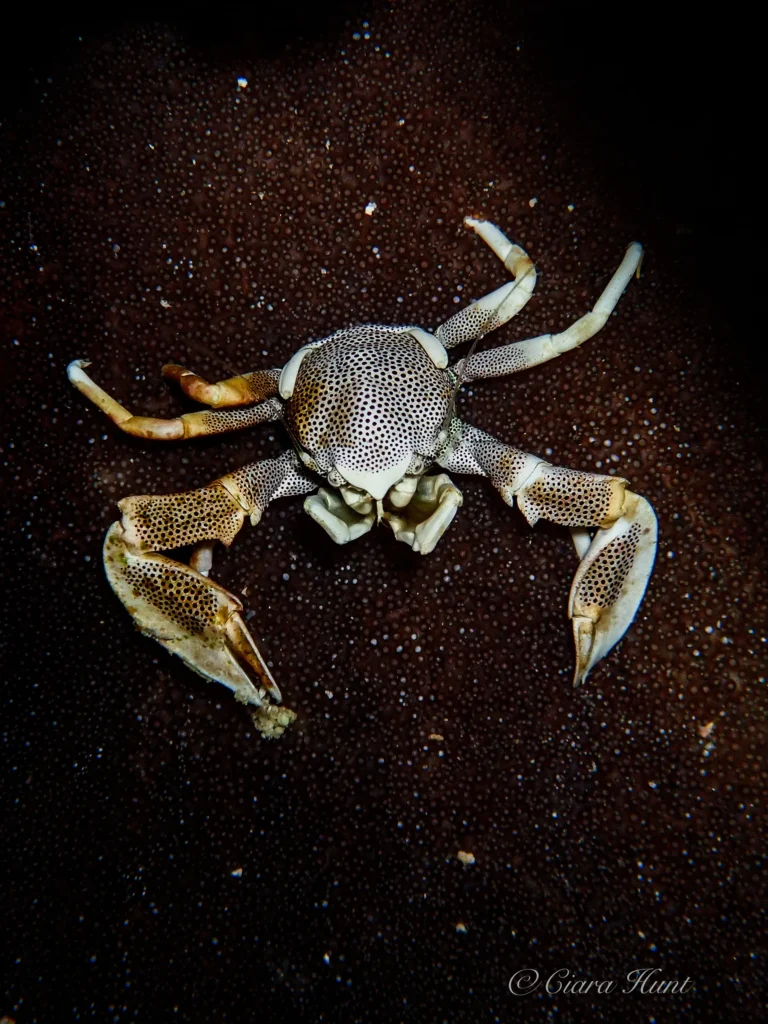
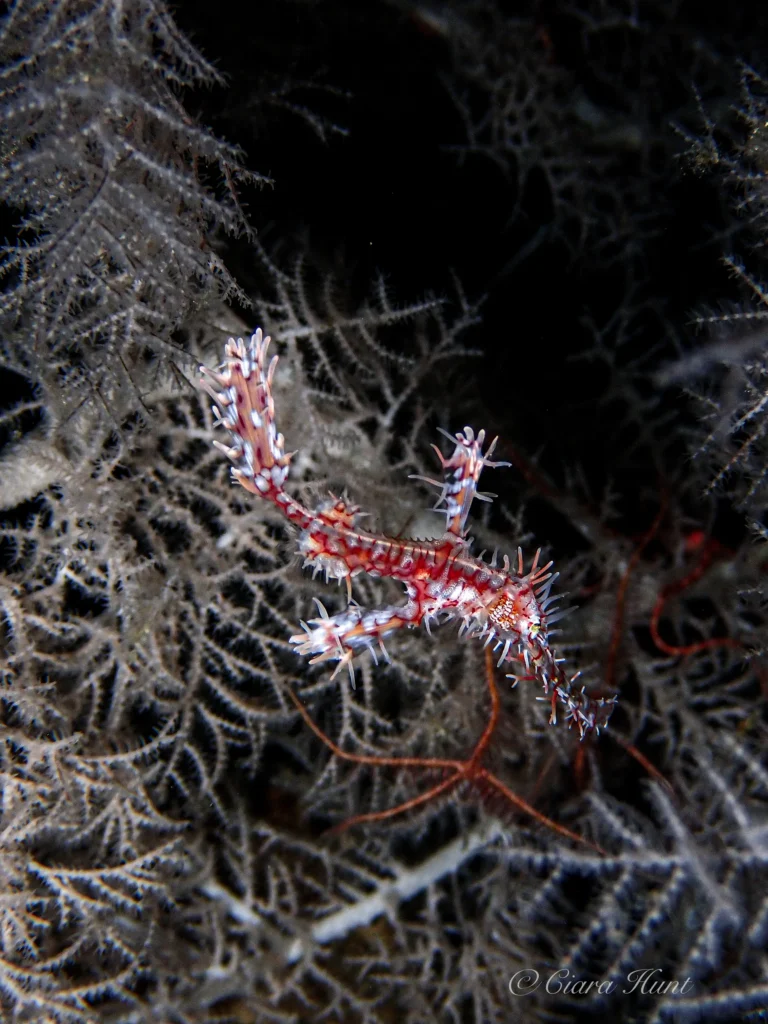
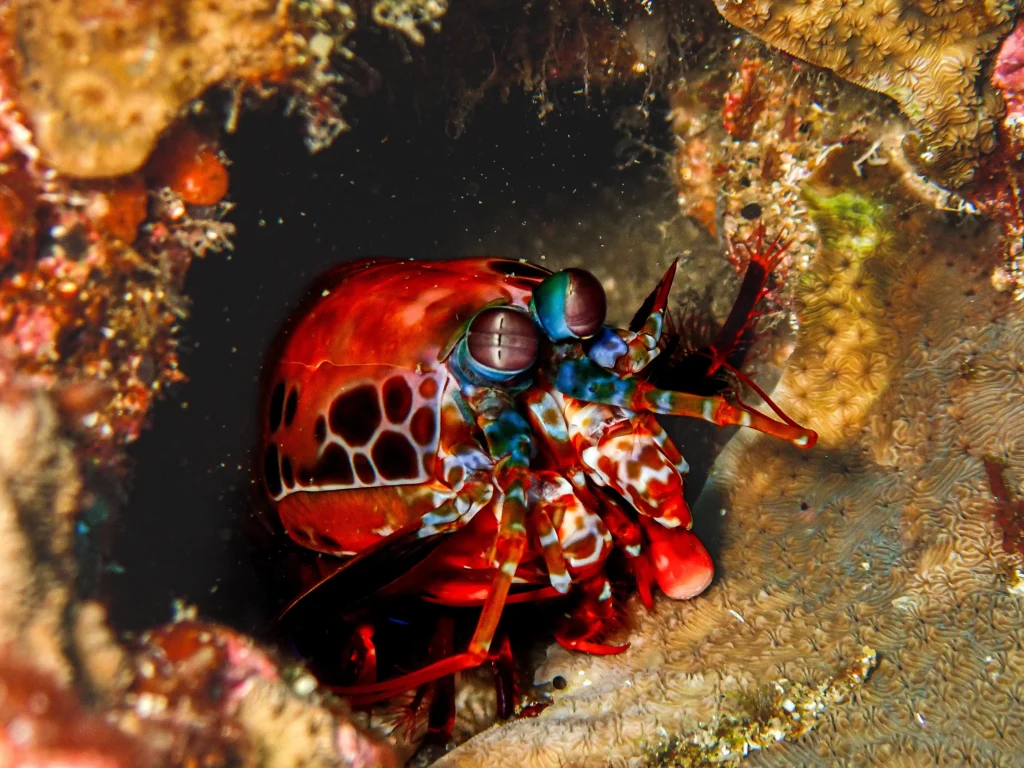
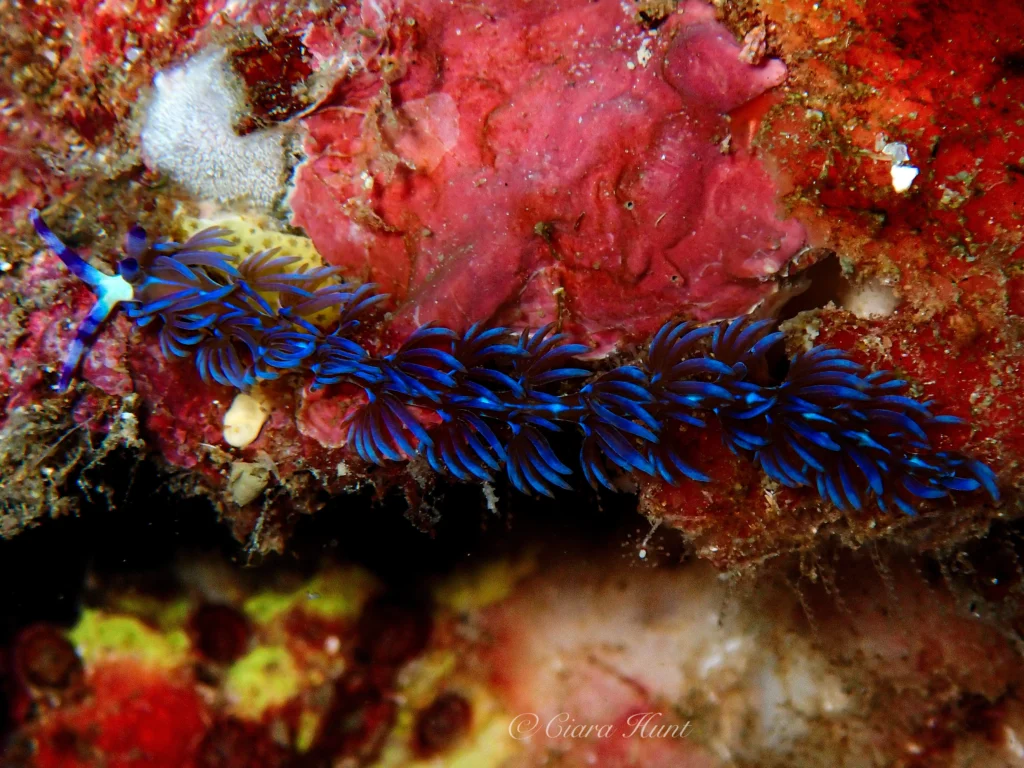
Incredible macro photos of some of the critters we saw, thanks to my friend Ciara Hunt (follow her on Instagram!)
My Favorite Dive Sites of the Trip
Now for the fun part! Let’s talk about the Similan and Surin Islands dive sites. On the trip, we had the opportunity to do 14 dives – and I’m pretty sure that everyone onboard did all 14 dives! There were a few dive sites that we did multiple dives at, mainly Richelieu Rock and Koh Tachai Pinnacle – which were honestly my two favorite dive sites.
I didn’t have a bad dive on our Similan’s liveaboard. Each dive was full of fish, beautiful coral, and stunning conditions. However, these were my favorites!
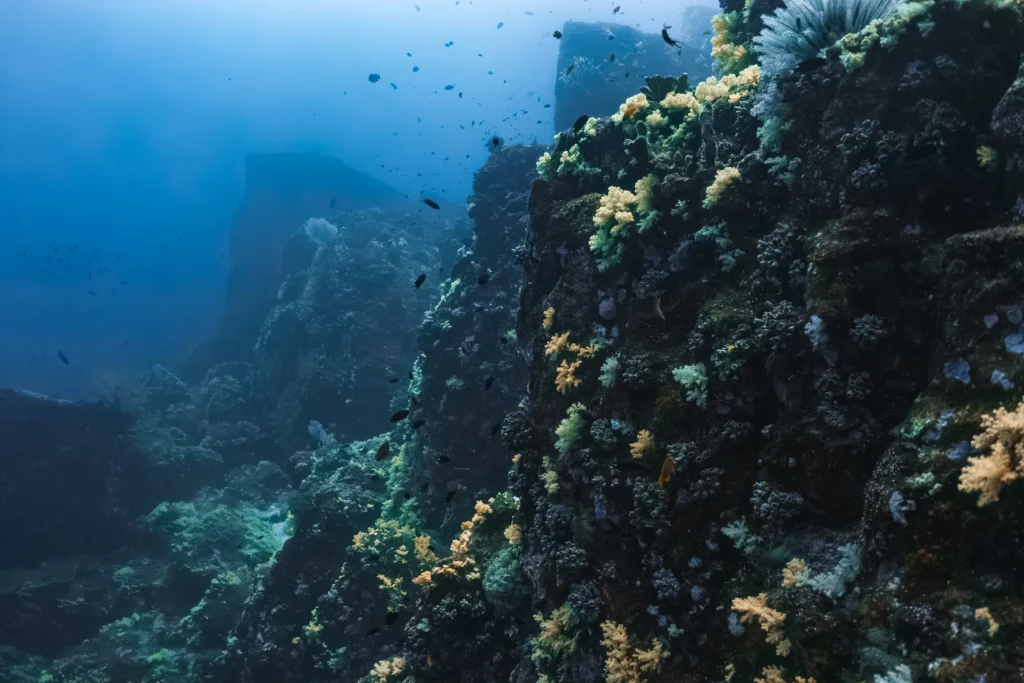
Christmas Point
Christmas Point was our first dive on day two. It’s a dive site in the Similan Islands National Park at Similan Island 9. I loved the topography of this dive site. It was full of huge underwater boulders and swim-throughs. One swim-through had a beautiful reflection from the diver’s bubbles collecting on the rock.
Our dive was nice and chill at Christmas Point, with visibility of around 20 meters and a light current. My max depth was 25.8 meters, and my average depth was 17.4 meters. The total dive time was 58 minutes.
On this dive, we saw a carpet anemone home to some porcelain shrimp. We also saw an amazing ribbon eel and our buddies saw an octopus at the start of the dive. Unfortunately, it retreated straight into its home, so we weren’t able to see it ourselves.
Overall, I loved this dive site because of the topography. It was such a fun site to explore. I would say it’s more for macro lovers, but if you enjoy a swim-through, you’ll love this dive site as well.
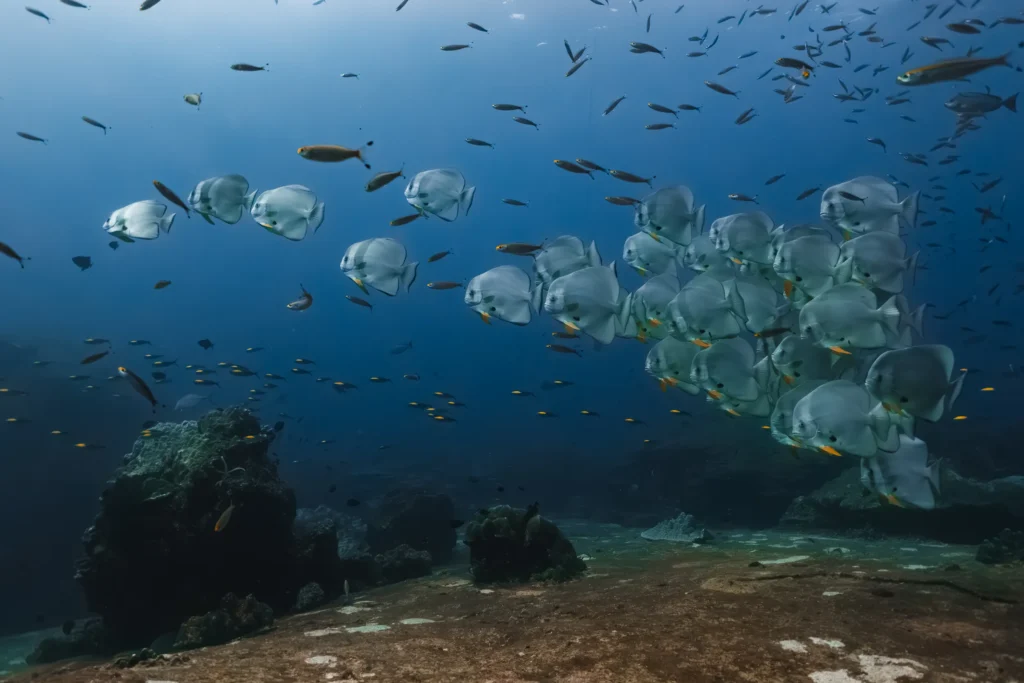

Koh Tachai Pinnacle
We did three dives at Koh Tachai, and each one was more amazing than the last. We got to do three dives at Koh Tachai; we did one morning, afternoon, and sunset dive. It was one of the last dives of our trip, and I am so grateful we got to go back! On all three dives, my max depth was around 23 meters, and my average depth was around 16 meters. Each dive was an hour long, but we all wished we could have stayed there longer.
There are two dive sites at Koh Tachai: the reef and the pinnacle. Our dive team decided to do the pinnacle each time – mostly because we all love a pinnacle dive. Koh Tachai Pinnacle is a massive granite plateau covered in soft corals, sea fans, and anemones. It’s common to have strong currents at this dive site – that bring food for the bigger fish.
We saw so much life at Koh Tachai! But here are the highlights from our three dives there:
- Tornado vortex of Barracuda (a dream of mine to see!)
- Spawning Barracuda
- Huge schools of fusiliers
- Yellow boxfish (our favorite fish!)
- A feeding frenzy of trevally, peacock groupers, and long face emperor fish
- Hunting trevally on every dive
- School of batfish
- Massive lobsters
Those were the highlights, but there was so much life at Koh Tachai. It was a fantastic dive site that I would love to return to!
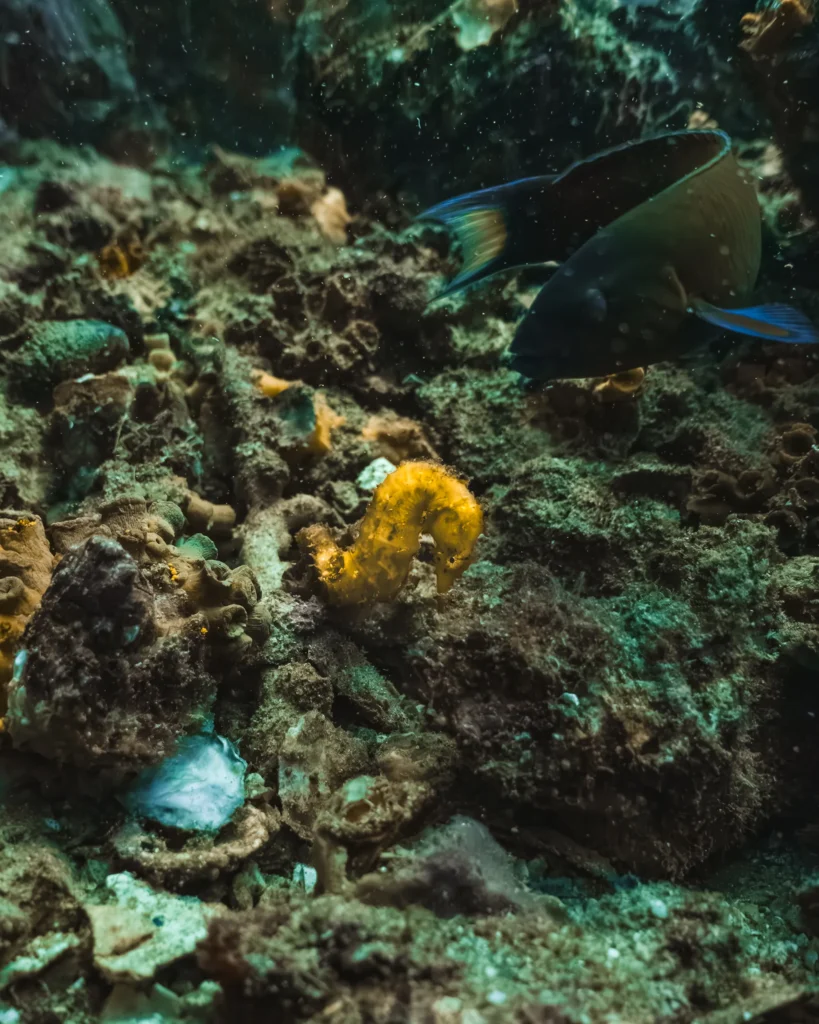
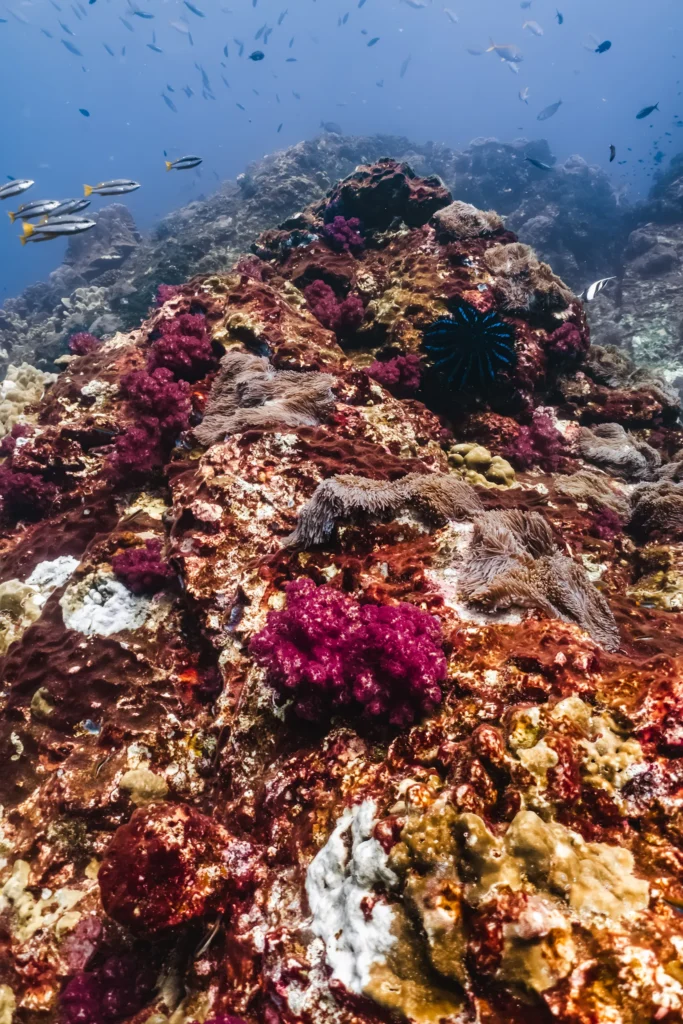
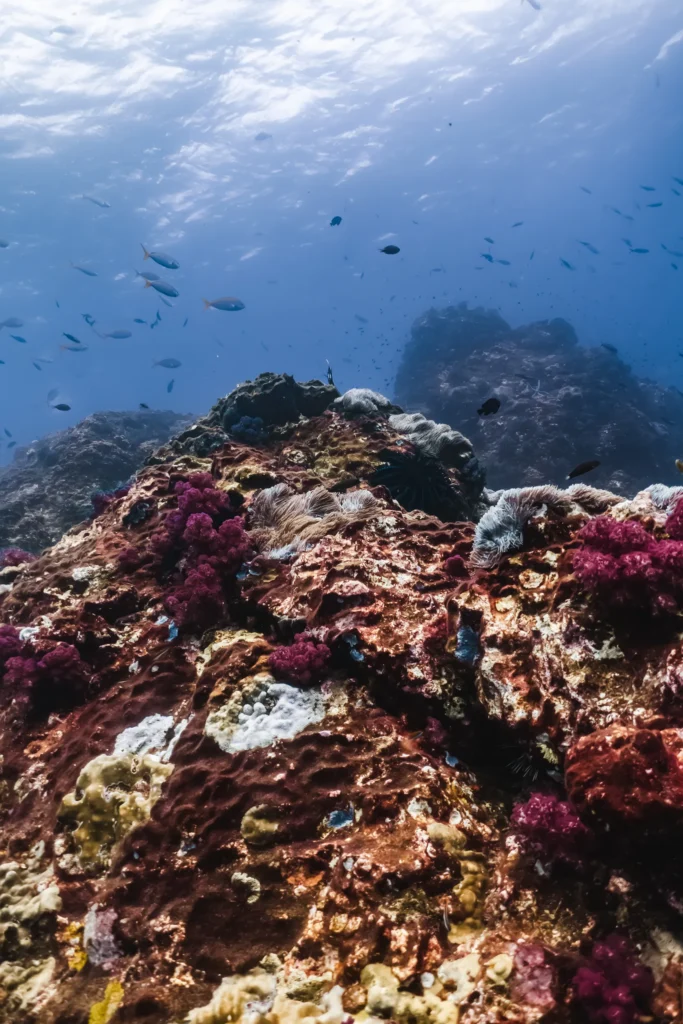
Richelieu Rock
And, of course, you can’t forget Richelieu Rock! It is the most famous dive site in Thailand – for good reason. This dive site lived up to its hype. You don’t know where to look. There is so much action happening all around you. Richelieu Rock is another site we did three times on our Similan Islands liveaboard.
Richelieu Rock is a pinnacle in the Surin Islands. The dive site is covered in soft and hard corals, sea fans, and anemones, and it’s famous for its abundance of marine life.
Our max depth on this dive was around 24 meters, and my average depth was just over 15 meters. Once again, each dive was an hour – and we did one in the morning, afternoon, and sunset. A strong surge current on the surface would pull you up during the safety stop, but otherwise, we got really lucky with light currents around the dive site.
Here are the highlights from our three dives at Richelieu Rock:
- Yellow seahorse
- Lots of yellow boxfish and blue spotted boxfish
- Ornate ghost pipefish
- Peacock mantis shrimp
- Lots of little moray eels
- Thousands upon thousands of glass fish
- Schools of fusiliers
- A huge school of trevally, rainbow runners, and long face emperor fish all swimming and hunting together
- Zebra morays
- School of batfish
I could do this dive site 100 more times and never get bored. I absolutely loved it.
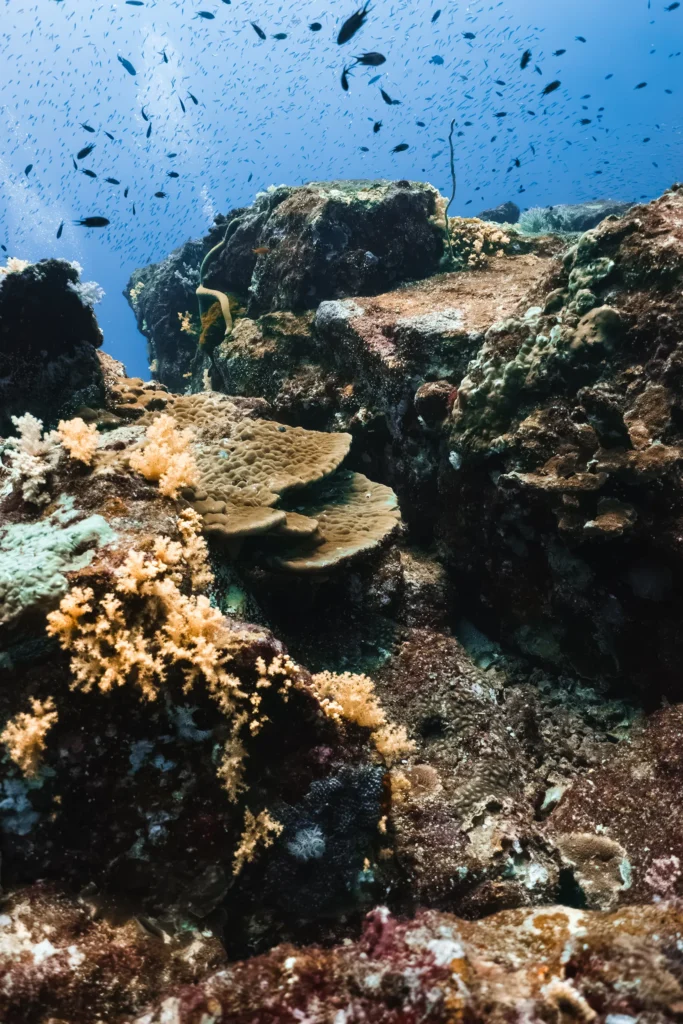

Koh Bon Pinnacle
You’ll start to notice a theme—I love a pinnacle dive site, and Koh Bon Pinnacle was no exception. This was our last dive of the trip and one of my absolute favorites.
Koh Bon Pinnacle is a deep dive site that feels entirely remote. It’s the sort of dive site where anything could appear out of the blue. The pinnacle starts at around 18 meters and drops down to 60 meters in some places. It’s covered in yellow soft coral, earning it the name ‘yellow rock’ in Thai.
Our max depth at this site was 28 meters, with an average depth of almost 18 meters. We still managed to have another hour-long dive, but after our NDLs ran out, we swam in the blue for about 20 minutes until we reached Koh Bon Reef, where we shallowed up and finished our dive.
At Koh Bon Pinnacle, I spotted a tiny mosaic moray (something I’ve never seen before!). We also saw a peacock mantis shrimp, the tiniest scorpionfish I’ve ever seen, a school of batfish, and a giant tuna.
The Similan and Surin Islands diving completely lived up to the hype. If you’re into marine biodiversity, doing a Similan Island liveaboard is a must.
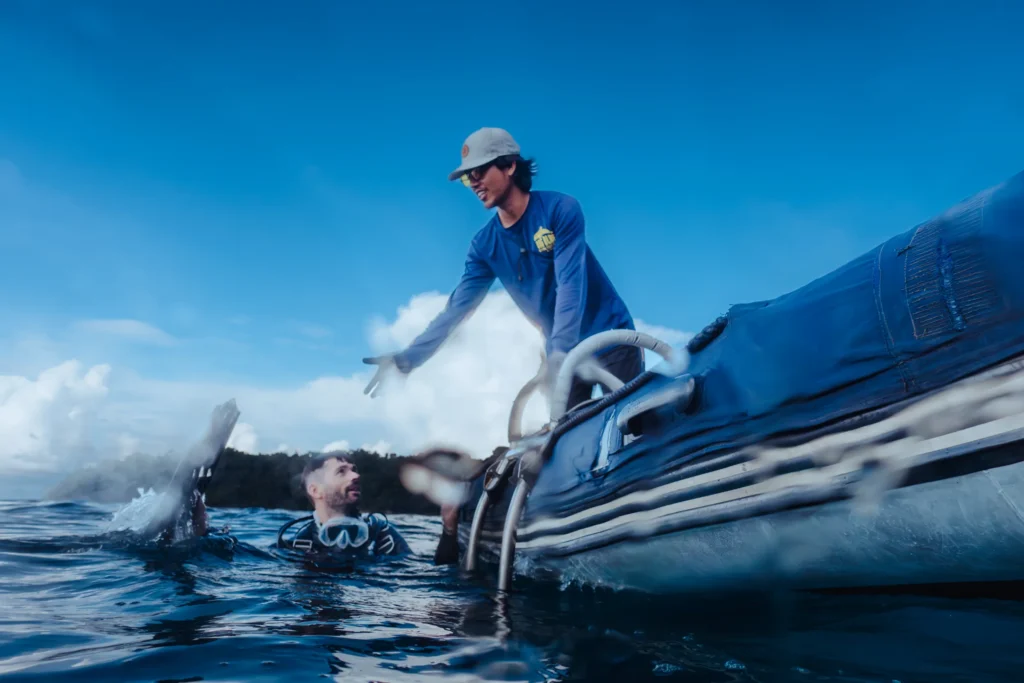
Safety Considerations and Dive Conditions
What are the diving conditions in the Similan and Surin Islands? In this section, I want to help you learn more about the general conditions of diving. However, please keep in mind that these were the conditions on our trip—the ocean is ever-changing, and there are a variety of factors that could impact your exact experience.
General dive conditions on our Similan Island liveaboard
- Visibility: We got lucky with amazing visibility on our trip. We had visibility between 15 and 30 meters on all of our dives.
- Water temperature: The average water temperature on our trip was between 29-30°C. I was grateful to be wearing a long, 5mm wetsuit, but there were other people on the trip in short wetsuits.
- Currents: Once again, I think we got relatively mild currents – there can be strong currents on these sites. There were some dives with medium to strong currents, but nothing too bad. We did have a lot of surge currents, but I always find those really fun!
Depths: Everyone was diving on nitrox, so we were able to extend our bottom times. Most of our max depths were over 20 meters, with average depths deeper than 15 meters. But there is a mix of deep and shallow sites, depending on what you like.
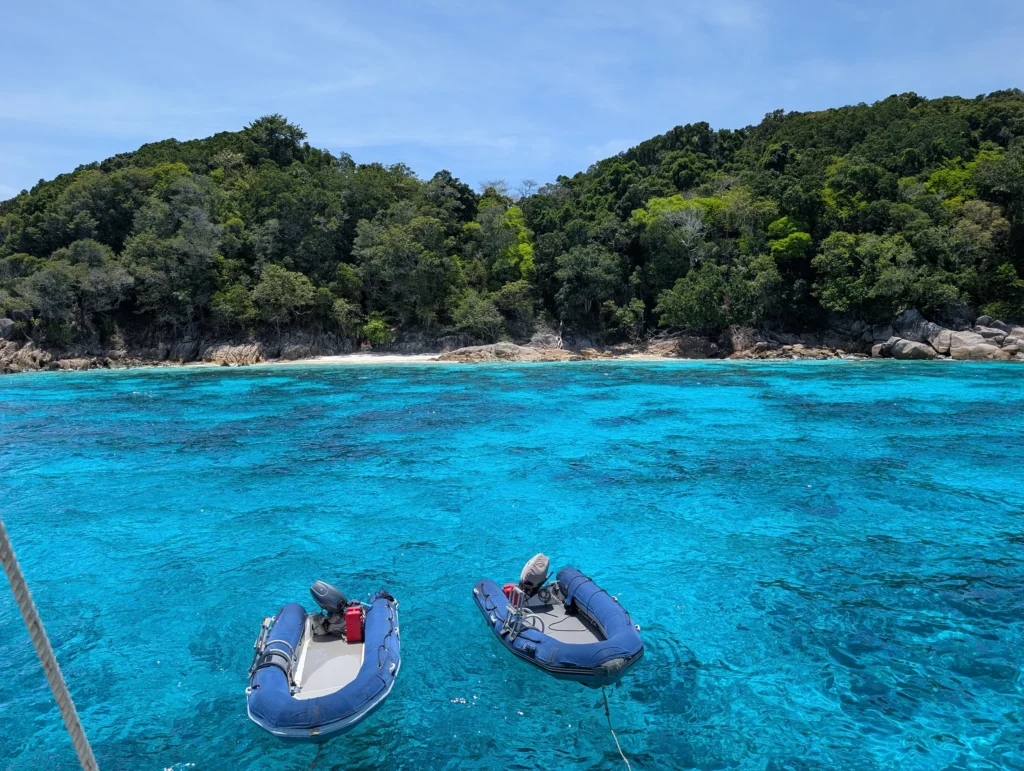
Safety Protocols on the Blue Dolphin
- Dive briefings: Before every dive, we had a thorough dive briefing with our guide, Will. He walked us through the plan, reminded us of safety procedures, and told us what to look out for on each dive.
- Equipment checks: We were always reminded to check our equipment and perform our buddy checks before getting into the dinghy. They stagger the groups so that there is plenty of room on the dive deck to get ready.
- Exit and entries: You start and end every dive from the dinghy and never have to surface swim. There were no negative entries, so you always had a chance to regroup before descending on your dive.
- Emergency equipment on board: The boat is equipped with everything you could need in an emergency, though luckily, nothing was needed on our trip. Boots made us all feel safe with his initial boat briefing, and they provided us with centrally located charging areas to protect us all.
- Staff qualifications and dive guide-to-diver ratio: I have nothing but praise for all of the staff onboard. Our guide, Will, was incredible. Not only was he great at helping us spot marine life, but he also made sure we felt comfortable before each dive. With the Blue Dolphin, the maximum group size is four divers to one guide.
One thing I noticed about the entire dive crew was their commitment to protecting the reef. We were each checked for our buoyancy control and proper weighting to help us maintain a safe distance from the reef.
No one onboard the Blue Dolphin used sticks, bells, or any other devices to interfere with marine life, and no one was seen touching the reef, corals, or marine life.
I am so grateful to see this care and responsibility for the reef from any dive tour operator, and I am happy to say that the Blue Dolphin team was outstanding.
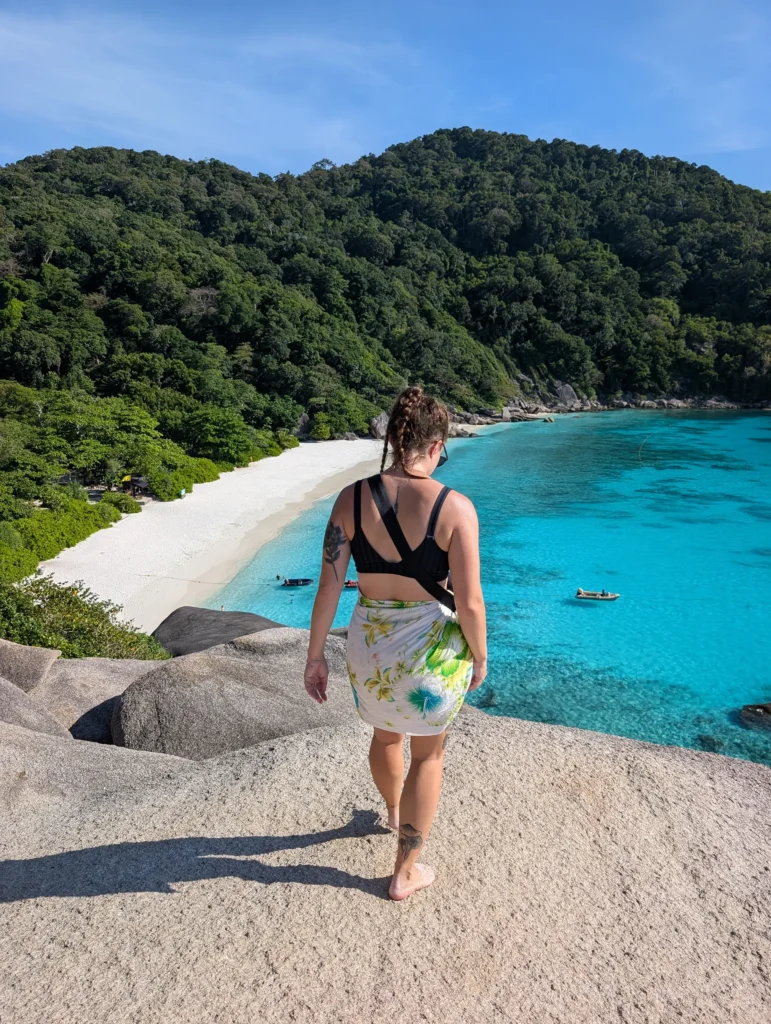
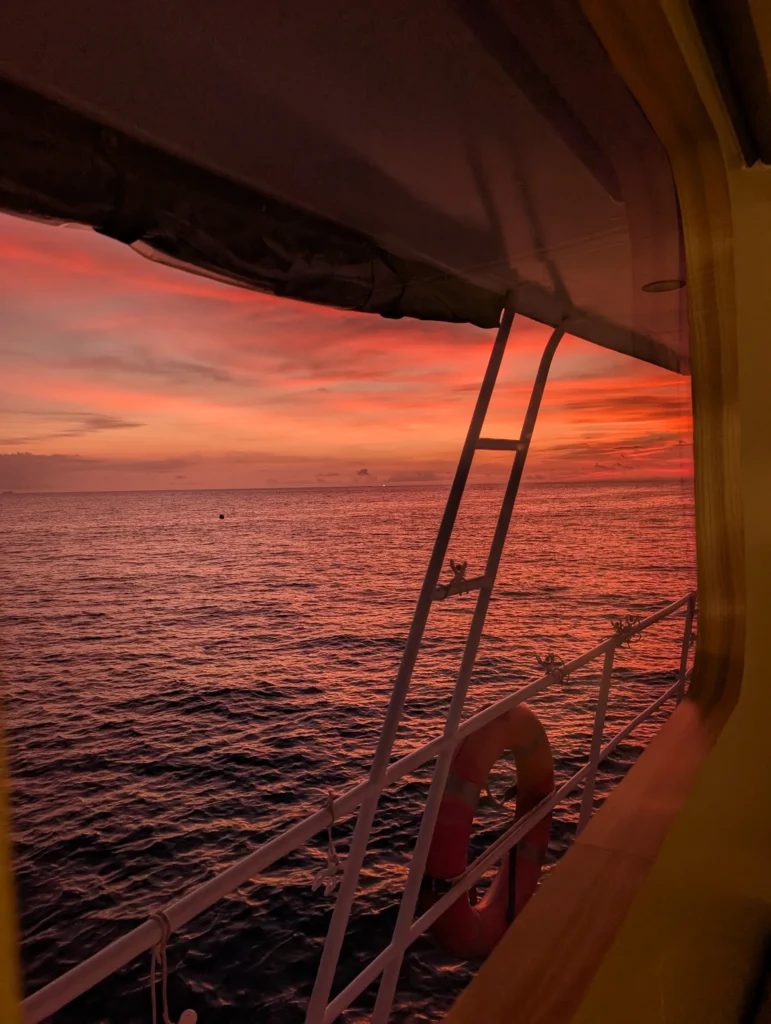
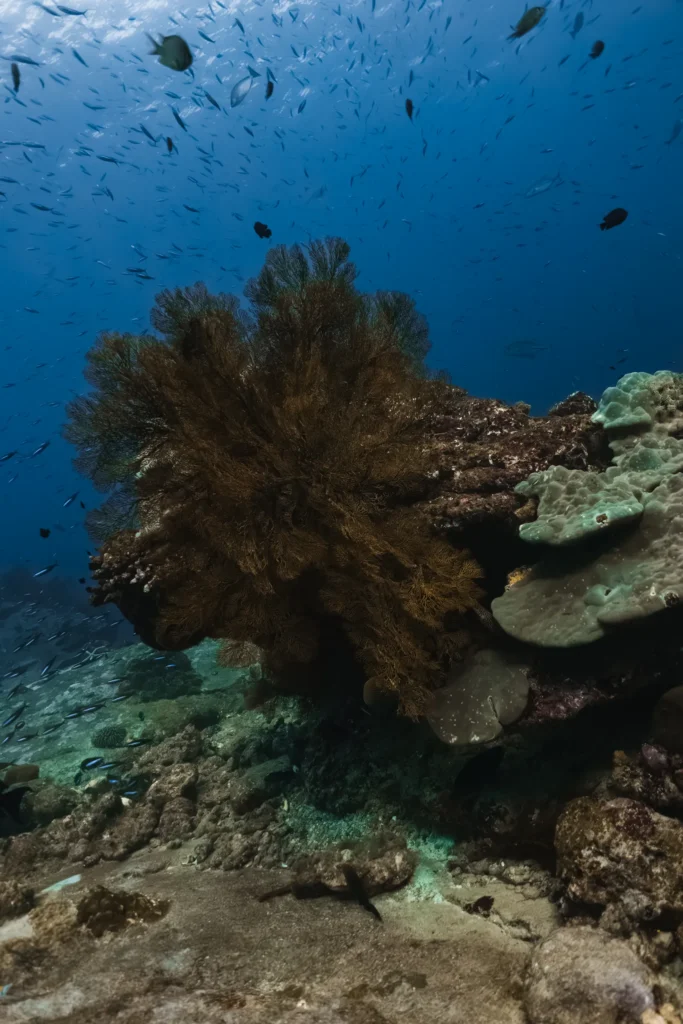
Experience Level Needed & My Personal Experience
This trip is best suited for Advanced and above-level divers. Our dives were pretty deep, and while we had mild currents, this part of Thailand is known for having strong currents. I recommend getting comfortable doing multiple dives in one day and diving in currents before booking your trip.
Having Nitrox is highly recommended, but you can get that certification on board! We also had one diver on our trip who was doing his advanced course, and he absolutely loved it.
Personally, I felt very well taken care of by the whole crew. Will helped me feel extremely comfortable on each dive.
I rented a BCD and regulator from them; both were well-maintained and cared for! I’ve done almost 300 dives around the world in a variety of conditions – and I didn’t find any of the dives on our Similan Islands Liveaboard that put me out of my comfort zone.

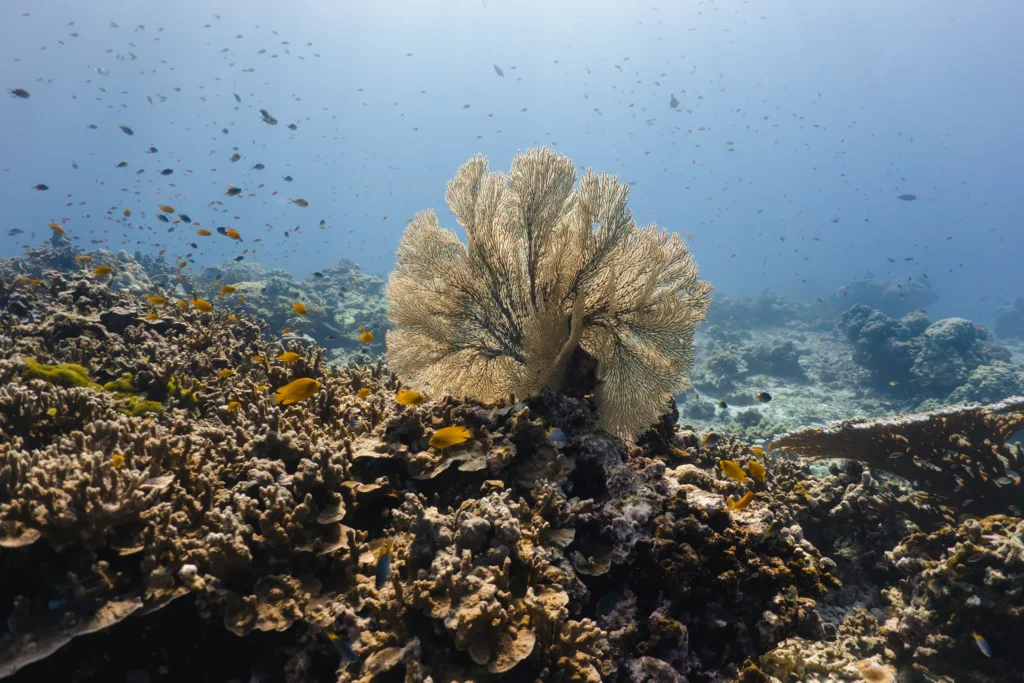
Booking and Costs
When it comes to booking your Similan Islands Liveaboard, you’ll have a lot of choices! There are a variety of boats, trips, and companies to choose from. I went with Big Blue Diving Khao Lak because of a personal recommendation, and we were blown away by the comfort and luxury of their boat.
The Blue Dolphin (review coming soon) was designed with hotel-style amenities in mind. The beds were comfortable, the food was amazing, and the atmosphere of the guests and crew was lovely.
They’re currently offering an early bird discount for their trips starting in October.

Our cabin on the Blue Dolphin! Don’t even get me started on the memory foam mattress. I slept so good!
What’s typically included in a liveaboard?
If you’ve never booked a liveaboard, you might wonder what’s included! You can typically expect these things included in your liveaboard cost:
- Accommodation
- Meals and snacks (we had three full meals and a light snack, but there was also coffee, tea, soft drinks, fruit and biscuits available all day)
- 3-4 dives per day
You will normally pay a bit more for Nitrox, equipment, and national park fees, but with the Blue Dolphin, everything else is included. They don’t have any sneaky hidden fees.
For up-to-date pricing and trip details, I recommend heading straight to Big Blue Khao Lak’s website. They offer price matching, which means that when you book directly with them, you’re always going to get the best price.
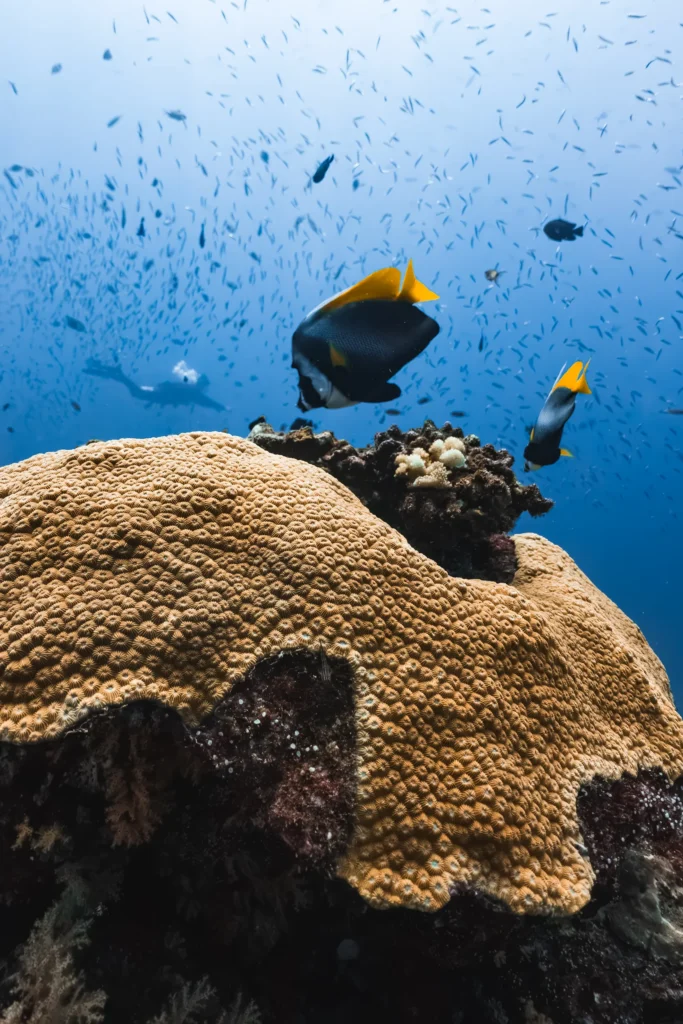
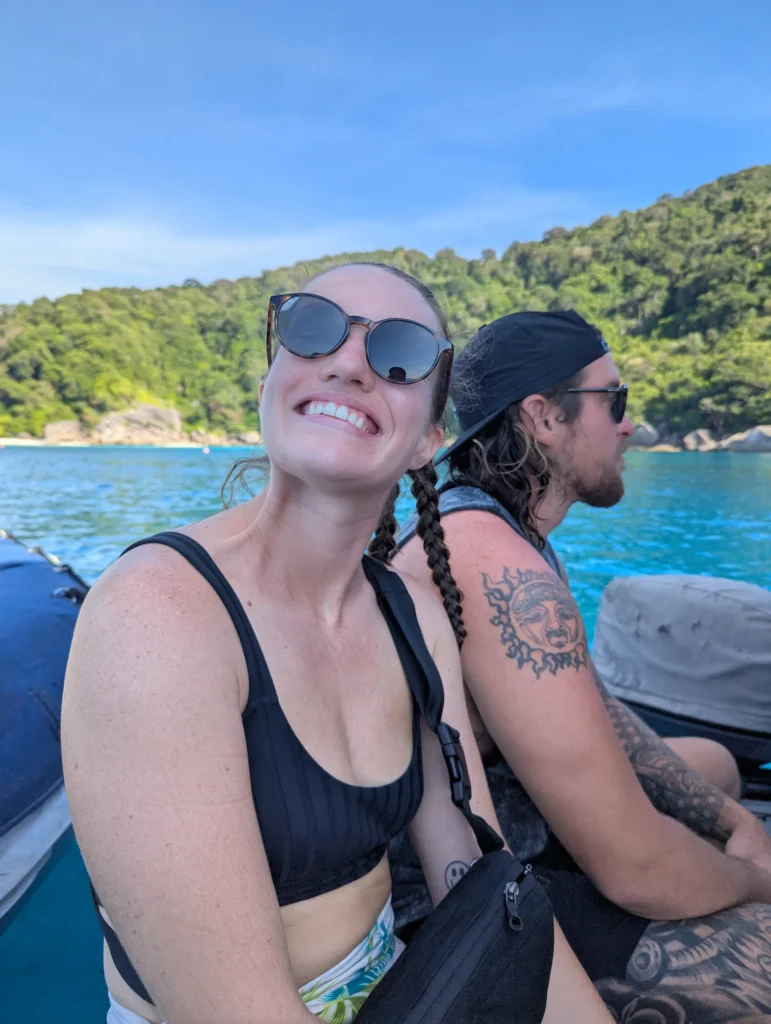
Tips for First-Time Liveaboard Divers
This is everything I wish someone had told me before my first liveaboard!
What to Pack (and What to Leave at Home)
- Reef-safe sunscreen, motion sickness pills (the Blue Dolphin had plenty, though!), dive logbook, reusable water bottle
- Electrolytes (the Blue Dolphin team also provided these)
- Two sets of swimwear; that way, you can always have one drying while you’re wearing the other
- A warm layer for windy evenings and a good hat/sunglasses for the sun
- I love my DJI Action camera for underwater shots
Don’t overpack—storage is limited, and trust me, you won’t need very much!
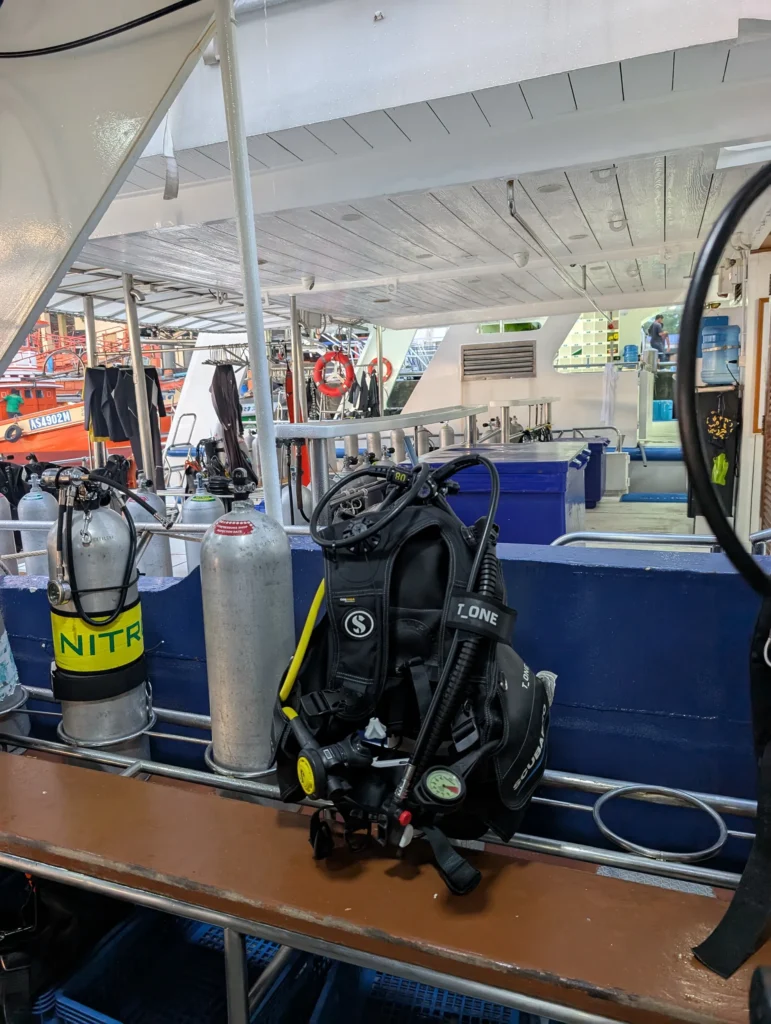

Prep Before Your Trip
- If you haven’t dived in a while, do a refresher course before the trip
- Get dive insurance (like DAN) that covers remote areas
- Double-check visa rules and health forms if you’re already in Thailand
Expect a Routine – and Love It!
You are going to get into the rhythm of eat-sleep-dive-repeat quickly. There’s a good reason why that was our motto for the trip. You might have trouble sleeping on the first night (I know I did!), but after doing four dives and being in the sun all day, you’ll sleep like a baby on night two.
Let yourself get into the rhythm of napping or resting between dives, eating plenty of tasty food, and diving four times a day.
Even if it’s not normally your routine, get used to going to bed reasonably early and getting up early. It’s part of the experience, and you’ll want to make sure you get enough sleep. The only time I ever watch the sunrise is from a dive boat – and it never disappoints.

Boat Etiquette & Liveaboard Life
The boat is small, so make sure you keep the space tidy—especially spaces that you are sharing with other people.
Take your time and wait your turn to gear up, use rinse tanks, adjust your camera, charge your batteries, and so on.
It’s also important to be patient with each other; you’re all getting used to life on a small boat!
Tipping the crew on a liveaboard is common – and very appreciated. The crew on Blue Dolphin went above and beyond to keep us safe, happy, and well-fed, and the tips are distributed evenly throughout their team. From my research and experience, you can expect to tip between 10-15% of your total liveaboard trip cost.

Mental + Physical Readiness
A Similan Islands liveaboard involves a lot of diving, and strong currents can make for more challenging conditions.
It’s so important that you listen to your body and skip a dive if you’re tired. Also– talk to the liveaboard team! They dive often, and they can help you hydrate and take care of yourself.
Speaking of which, hydrate often. The Blue Dolphin had electrolyte packets that you could add to your water. If your liveaboard doesn’t have amenities like that, bring some for yourself. You should also eat something, even if you’re not hungry. You’ll need the energy!
Don’t stress yourself out. Make sure to turn to the team and voice your questions or concerns. If you need help with the gear, you can’t remember where something is, or you’re feeling really tired and want to sit and dive out, just let them know. The crew is there for a reason!
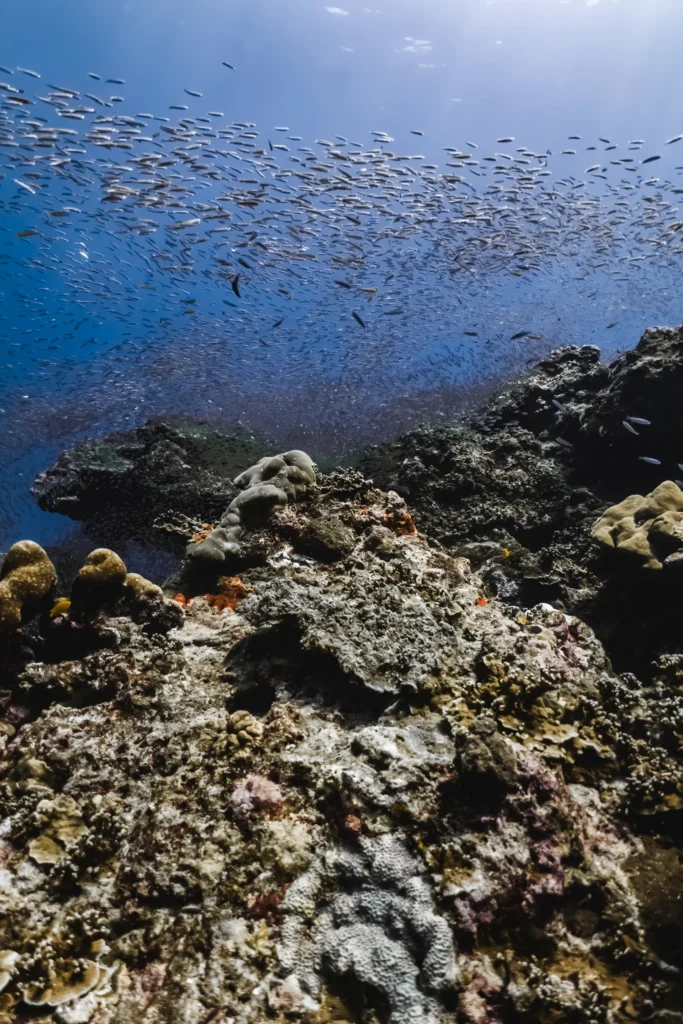
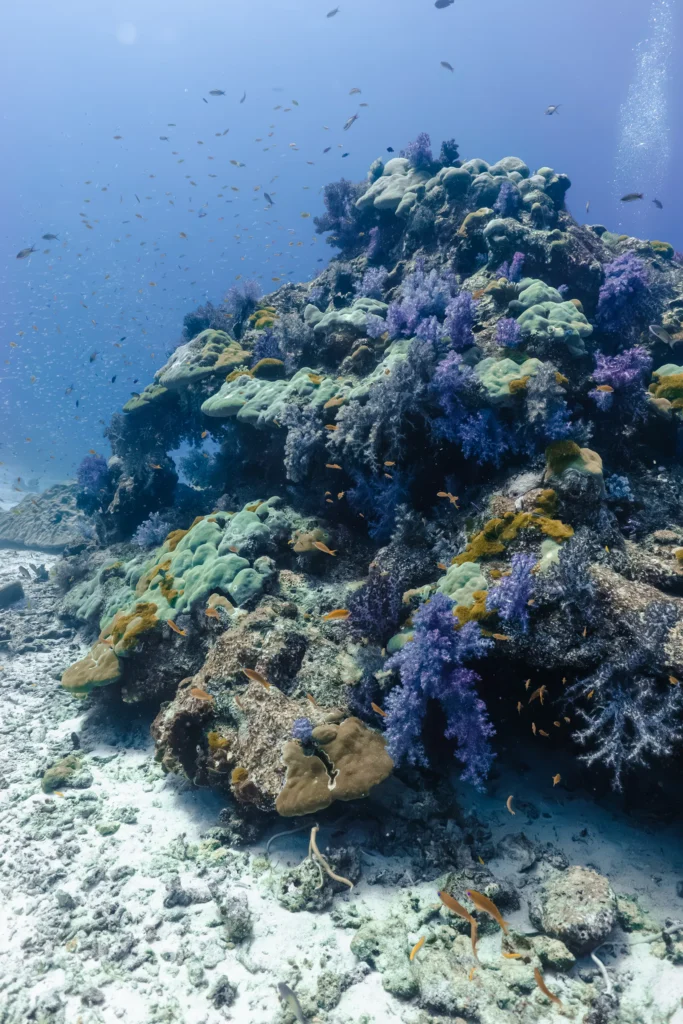
Mindset Tips
I highly recommend disconnecting and enjoying being offline. I do not recommend trying to work while you’re on a liveaboard. You can’t rely on wifi or cell signal at certain times in the Similan and Surin Islands.
Wifi-fi, just fish. Enjoy the chance to disconnect! The world will still be there when you get back to shore.
Remember to be friendly. The best thing about diving is that you already have so much in common with the people on your trip with you! They probably love diving just as much as you. A liveaboard is the perfect place to make new life-long friendships.
Lastly, be flexible. The ocean is not a zoo, and the weather cannot be controlled by anyone. The crew wants you to have the best trip possible, but their top priority is getting you back to shore safely. That being said, conditions can change, and plans may shift. That’s all part of the adventure.
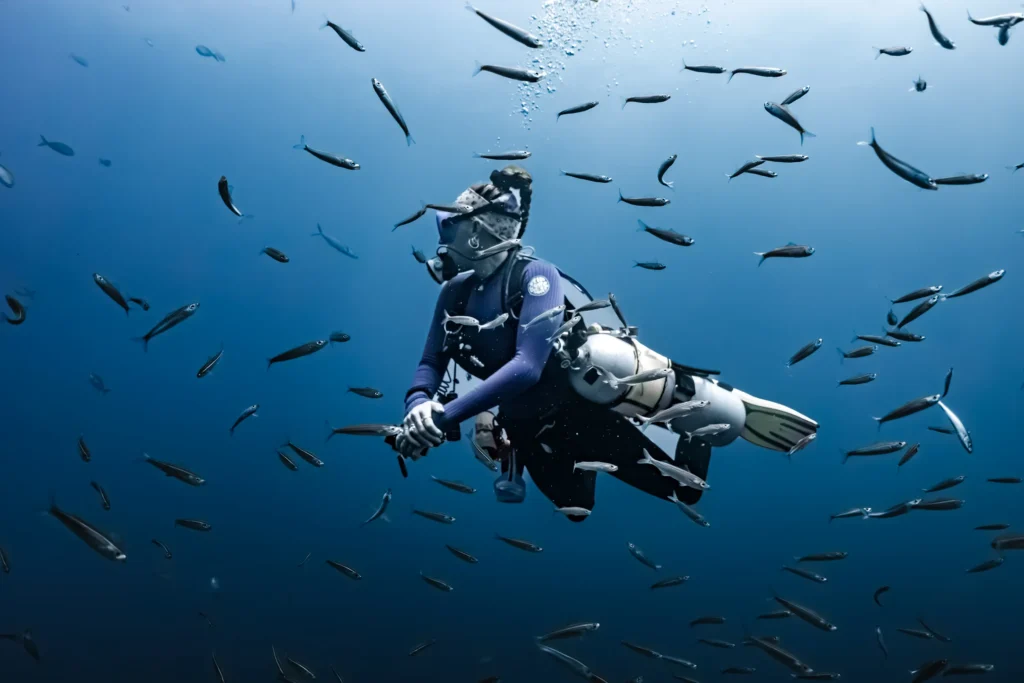
FAQs
Are you ready to embark on your Similan and Surin Islands liveaboard with the Blue Dolphin? I hope this blog post has helped you learn more about a Similan Island liveaboard and inspired you to book your trip!
Here are some frequently asked questions that I’ve had from people– when I’ve told them I was going on a diving liveaboard! If you have any more questions, please ask me in the comments below or email the Big Blue Diving Khao Lak team.
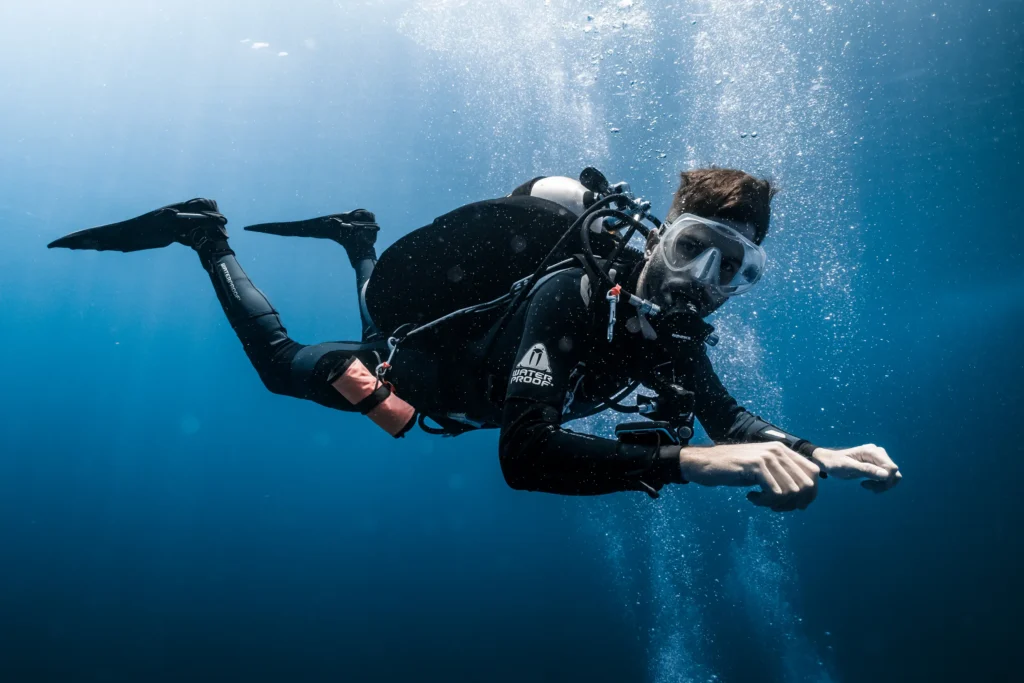
Do I need to be an experienced diver to join a liveaboard?
Many liveaboards, including the Blue Dolphin, will teach you additional courses like Advanced and Nitrox on the boat. Taking a course can be an amazing way to gain experience. Still, speaking from my personal experience, you should get experience as a diver before going on a liveaboard.
I’m so grateful that I waited to go on a liveaboard until I was a rescue diver with over 100 dives. I know that’s not feasible for everyone, but it helped me feel more comfortable and enjoy the dives more overall. In my personal opinion, I would recommend that you have 50+ dives before booking your first liveaboard.
If you want to get more experience before your trip, book some fun dives at home! I know it might not be the most exciting diving, but you can dive almost anywhere– and that can help you gain experience and feel more confident when you take trips like this.
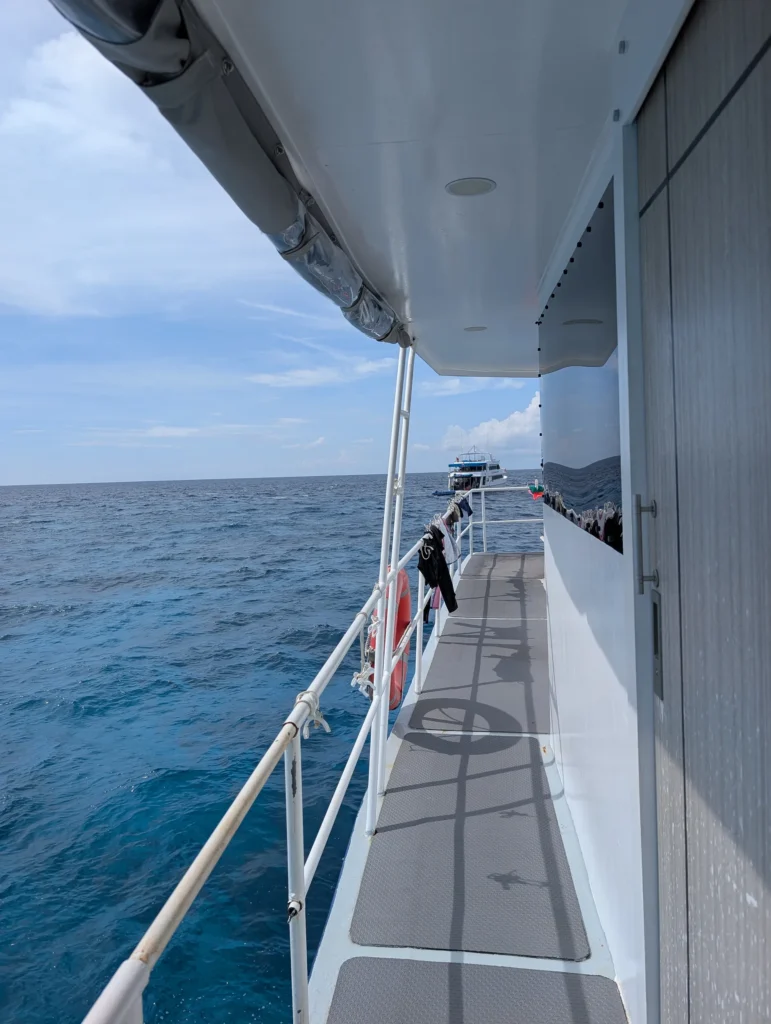

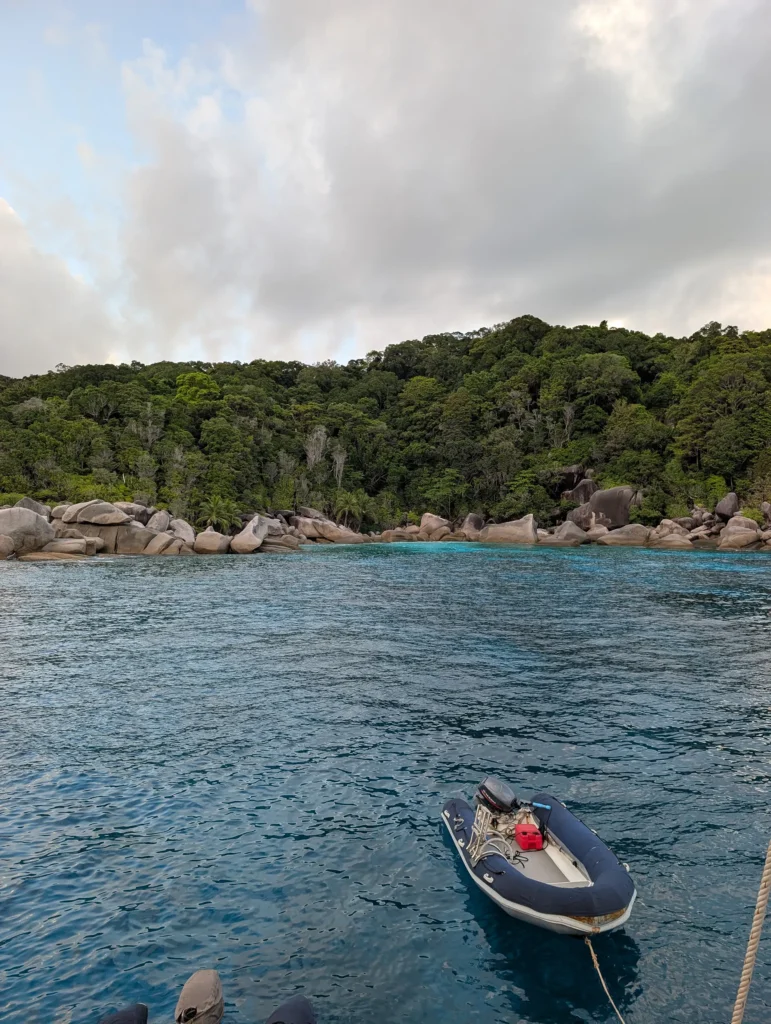
How many dives do you usually do per day on a liveaboard?
You can do anywhere from 2-4 dives per day on a liveaboard. With my Similan Islands liveaboard, we did three days of four dives and one day of two dives. I’ve seen liveaboards that do more and less than that – but no one does more than four dives in one day.
Can I join a liveaboard as a solo traveler?
Yes! And it’s such a great way to meet travelers. Keep an eye out for trips that are geared more toward solo travelers. I know many female-led diving trips are geared toward solo female travelers, and I would love to do one!
Will I get seasick on a liveaboard?
You might! I know I did on the first night. I tend to get seasick quite easily – and I felt grateful that I only got it on the first night. Remember to take sea sickness pills, and you can choose a lower deck cabin if you’re more prone to seasickness like me.

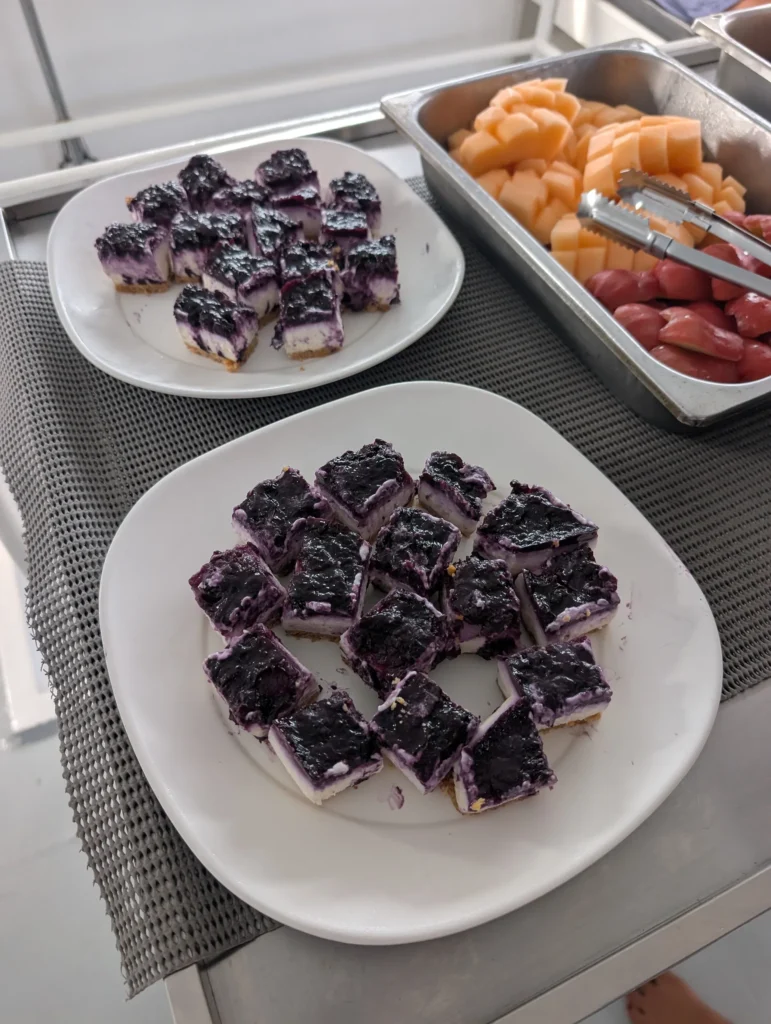
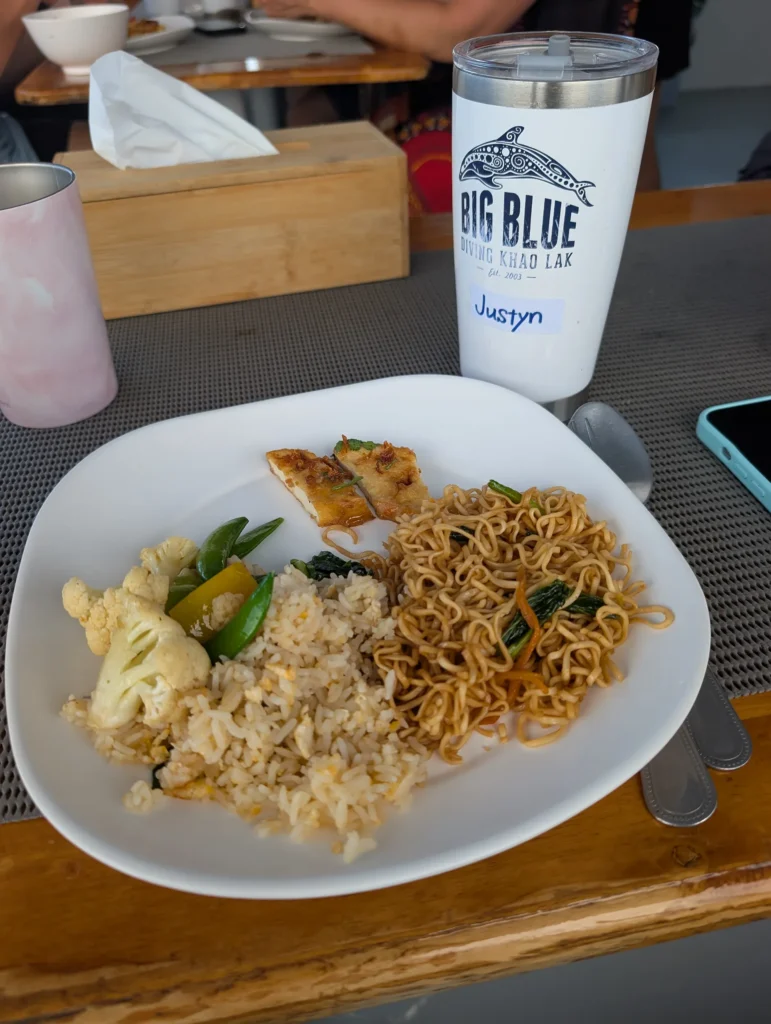
What’s the food like on a liveaboard?
The food on a liveaboard can vary drastically. The Blue Dolphin had an incredible chef who made the most flavorful, fantastic food (including blueberry cheesecake!), and they could accommodate any dietary restrictions.
If you’re worried about the food, read reviews and see what other travelers have said before you. Once you’re on board, you won’t have any other dining options, so if they don’t have great food, there’s not much you can do.
Also, make sure that you let them know about allergies and dietary requirements before your trip! They have to buy everything before you leave, so meals have to be planned accordingly.

Is the wifi on a liveaboard?
There is wifi available on many liveaboards these days, but you are out at sea, so that doesn’t mean it will always work. My tip is to make sure you don’t need to rely on wifi for anything. Let people know they won’t be able to reach you for a few days, and enjoy the time away.
What questions do you have about a Similan Islands liveaboard?
Planning more diving trips around Southeast Asia? Read some of my other diving guides next.
- The Ultimate Guide to Koh Tao Diving
- Everything You Need to Know About Diving in Sipadan (with Dive Logs)
- I Stayed on the World’s First Dive Rig (Seaventures Review)
Love this travel guide? Much like a cup of coffee, I pour my heart and soul into each post! Say thank you by buying me a cup of coffee. Support this blog and keep it ad-free.
If you want to see where in the world I am, make sure to follow me on Instagram and TikTok.


